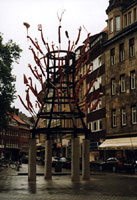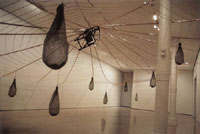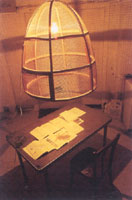page3
Dada
is Dead, Beware of the Fire!
An Interview with Huang Yong Ping
by Ya-Ling Chen
| click
to enalrge |
 |
Figure
17 |
|
Huang Yong Ping, Thousand
Armed Buddha, 1997
|
TF: You installed a giant bottle dryer with various objects of our daily life attaching to the end of the racks in the "Muenster Installation Project" of 1997. Through the outsized form and dancing objects, the relation between the signifier and the signified becomes evident. First of all, why the title Thousand Armed Buddha (Fig. 17)? Any indication in terms of the selection of the hanging objects?
HYP: Bottlerack is commonly perceived as "erotica" in terms of the protruding rack, as if it is an invitation for the bottle opening. I borrow this original meaning, if any, and transform the object into an Eastern Thousand Armed Buddha. Fifty "arms" grasp fifty objects on the enlarged bottlerack. Some are symbolic objects deriving from Buddhism, such as a steel bowl, a Goddess of Mercy bottle, a small pagoda, a spiral sea shell, a lotus flower, a snake, etc. Others are our daily objects incongruent with religious context, including a broom, a feather duster, and a cane. Hence, the indifference and estrangement of the ready-made is disenchanted and concealed by multiple symbols. This sculpture juxtaposes contexts of two cultural backgrounds, allowing them to correct each other.
TF: In 1917, the Blind Man journal published an article entitled "Buddha of the Bathroom" after Duchamp's Fountain was rejected by the jury of the Society of the Independent Artists, commenting upon the irony of the event. It is intriguing you also take on Buddha as an East-meets-West connection.
HYP: I am not sure about the association between Fountain and Buddha. If in fact there is a formal similarity between Fountain and Bottlerack, it must be the narrow-to-wide shape from top to bottom, resembling a "seated Buddha." Therefore, if Fountain transforms into a meditating Buddha, then Bottlerack is naturally a "Thousand Armed Buddha."
| click
to enalrge |
 |
|
Figure
18
|
|
Huang Yong Ping, The
Saint Learned from a Spider to Weave a Cobweb,
1994
|
|
Figure
19
|
|
Huang Yong Ping, The
Saint Learned from a Spider to Weave a Cobweb,
1994
|
TF: Can you describe The Saint Learns from a Spider to Weave a Cobweb (1998) (Fig. 18)? It is said that when you were in the process of installing, it reminded you of Duchamp as well, especially the projected shadow, and the hanging approach?
HYP: The title, The Saint Learned from a Spider to Weave a Cobweb, derived from the wisdom of a Taoist philosopher. In 1994, I had created a work bearing the same title for The "Hommages à Marcel Duchamp" exhibition organized by the Fine Art Academy of Rouen. It has a direct association with Marcel Duchamp. A live spider crawls slowly on a transparent glass panel, on the bottom of a lampshade-like bamboo cage. The Moving shadow of the spider is projected on a photocopy of Dialogues with Marcel Duchamp I placed on the table directly beneath the bamboo cage (Fig. 19)--is the spider reading? In the meantime, the spider shadow resembles a two-dimensional projection of the three-dimensional hatrack! I also used the same title for the 1997 project at the Galerie Beaumont Iro, Luxembourg, with some changes. Instead of the live spider, in a giant vertical cobweb the projected shadow of a coatrack is transformed into a multiple-armed chair. The chair in the center returned to the traditional Master Armchair in the 1998 version of the same work in New York.













